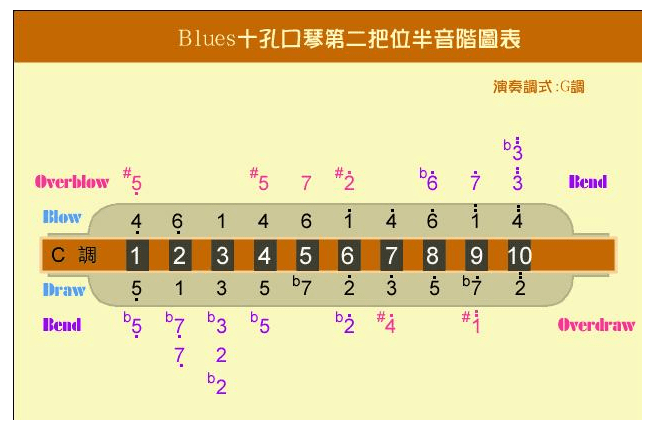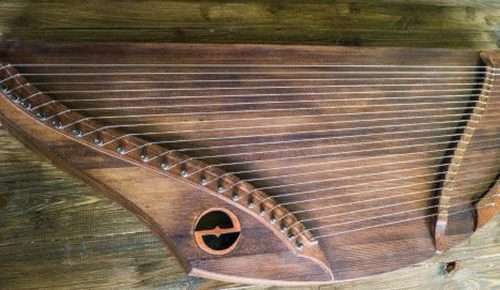
Harmonica. Exercises with Scale C major.
See Harmonica in the Muzyczny.pl store
The C major scale as a basic exercise?
Once we manage to produce clear sounds on individual channels of our instrument, both on the inhale and exhalation, we can start practicing on a specific melody. As the first such basic exercise, I propose the C major scale, the mastery of which will allow us, above all, to learn the pattern of what sounds we have on the inhalation and which on the exhalation. At the beginning, I encourage you to use a diatonic ten-channel harmonica in the C tuning.
When starting the game, remember about the narrow mouth layout, so that the air goes directly only to the designated channel. We start by exhaling, i.e. blowing into the fourth channel, where we get the sound C. When we breathe air on the fourth channel, we get the sound D. When we blow into the fifth channel, we get the sound E, and by inhaling the fifth channel we will have the sound F. the sixth channel we will get the G note, and the drawing in the A. To get the next note in the C major scale, that is the H note, we will have to inhale the next seventh stool. If, on the other hand, we blow air into the seventh channel, we get another note C, this time an octave higher, the so-called once specific. As you can easily see, each channel has two sounds, which are obtained by blowing or drawing air. Using four channels out of ten we have in our basic diatonic harmonica, we are able to perform the C major scale. So you can see how much potential this seemingly simplest harmonica has. When practicing the C major scale, remember to practice it in both directions, i.e. start from the fourth channel, go right to the seventh channel, and then come back playing all the notes one by one to the fourth channel.
Basic techniques for playing the C major scale
We can practice the known range in several ways. First of all, you start with this exercise at a slow pace, focusing on making all the sounds of the same length, with equal spacing from each other. The intervals between individual sounds can be planned longer or shorter. And if we want to clearly separate individual sounds from each other, then we can use the so-called the staccato technique of playing a note briefly, thus clearly separating one note from another. The opposite of staccat will be the legato technique, which is characterized by the fact that the sound from one to the other is designed to move smoothly without unnecessary pause between them.
Why is it worth practicing scale?
Most of us, when starting our adventure with the harmonica, immediately want to start learning by playing specific melodies. It is a natural reflex of every learner, but when practicing the scale, we practice many elements that are common to the melodies played later. Therefore, such an important and important element in our education should be practicing the scale, which will be such a starting musical workshop for us.
It is also good to be aware of what sound we are playing at a given moment, which channel we are on and whether we are doing it while inhaling or exhaling. Such mental concentration will allow us to quickly assimilate individual sounds to a given channel, and this in turn will make it easier for us to quickly read new melodies from notes or tablature in the future.
Things to keep in mind when exercising
First of all, no matter what exercise we do, whether it is a scale, exercise or an etude, the basic principle is that the exercise should be performed equally. The best guardian for keeping an eye on the pace will be the metronome, which cannot be fooled. There are many types of metronome on the market, traditional mechanical and modern digital. Regardless of which one we are closer to, it is good to have such a device, because thanks to it we will be able to measurably observe our progress in education. For example: starting an exercise at a pace of 60 BPM, we can gradually increase it by, for example, 5 BPM and we will see how long we will be able to achieve a pace of 120 BPM.
Another recommendation for the exercises that you do is, in addition to doing them at a different pace or technique, do them with different dynamics. For example, in our example of the C major scale, play very softly the first time, i.e. piano, the second time a little louder, i.e. mezzo piano, the third time even louder, i.e. mezzo forte, and play loud the fourth time, i.e. forte. Remember, however, with this forte not to overdo it, because blowing or drawing in too much air can damage the instrument. The harmonica is quite a delicate instrument in this respect, so you should approach such a very loud exercise with caution.
Summation
When it comes to practicing a musical instrument, regularity is the most important thing, and there is no exception to this when it comes to the harmonica. Regardless of what we intend to play or practice on a given day, the range can be our basic practice before the target exercise or concert.





